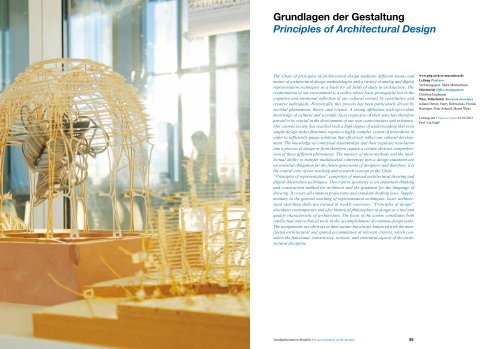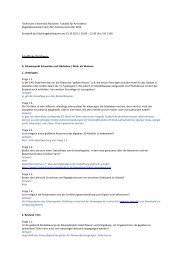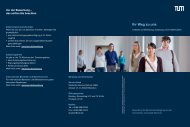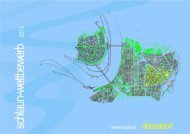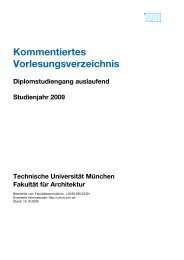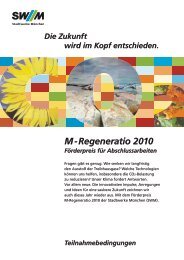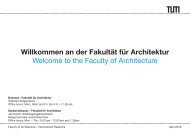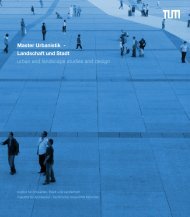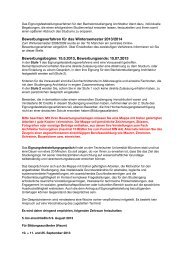Institute Institutes - Fakultät für Architektur - TUM
Institute Institutes - Fakultät für Architektur - TUM
Institute Institutes - Fakultät für Architektur - TUM
Sie wollen auch ein ePaper? Erhöhen Sie die Reichweite Ihrer Titel.
YUMPU macht aus Druck-PDFs automatisch weboptimierte ePaper, die Google liebt.
Grundlagen der Gestaltung<br />
Principles of Architectural Design<br />
The Chair of principles of architectural design mediates different means and<br />
matter of architectural design methodologies and a variety of analog and digital<br />
representation techniques as a basis for all fields of study in architecture. The<br />
conformation of our environment is a reality whose basic prerequisite lies in the<br />
cognitive and emotional reflection of our cultural context by constitutive and<br />
creative individuals. Historically, this process has been particularly driven by<br />
societal phenomena, theory and science. A strong affiliation with up-to-date<br />
knowledge of cultural and scientific facts respective of their time has therefore<br />
proved to be crucial in the development of our own consciousness and existence.<br />
Our current society has reached such a high degree of understanding that even<br />
simple design tasks oftentimes require a highly complex system of procedures in<br />
order to sufficiently gauge solutions that effectively reflect our cultural development.<br />
The knowledge of contextual relationships and their requisite translation<br />
into a process of design or form therefore require a certain abstract comprehension<br />
of these different phenomena. The mastery of these methods and the intellectual<br />
ability to transfer multifaceted coherences into a design statement are<br />
an essential obligation for the future generation of designers and therefore, it is<br />
the central core of our teaching and research concept at the Chair.<br />
“Principles of representation” comprises of manual architectural drawing and<br />
digital illustration techniques. Descriptive geometry is an important thinking<br />
and construction method for architects and the grammar for the language of<br />
drawing. It covers all common projections and standard drafting laws. Supplementary<br />
to the general teaching of representation techniques, basic architectural<br />
sketching skills are trained in weekly exercises. “Principles of design”<br />
elucidates contemporary and also historical philosophies of design as a tool and<br />
quality characteristic of architecture. The focus of the course conciliates both<br />
intellectual and technical tools in the accomplishment of common design tasks.<br />
The assignments are abstract in their nature but always balanced with the manifested<br />
architectural and spatial accumulation of relevant criteria, which considers<br />
the functional, constructive, tectonic, and structural aspects of the architectural<br />
discipline.<br />
54 Vorabpräsentation Modelle Pre-presentation of the models<br />
55<br />
www.gdg.arch.tu-muenchen.de<br />
Leitung Professor<br />
Vertretungsprof. Mark Mückenheim<br />
Sekretariat Office management<br />
Christine Englmann<br />
Wiss. Mitarbeiter Research associates<br />
Juliane Demel, Harry Dobrzanski, Florian<br />
Hartinger, Peter Schmid, Maren Weitz<br />
Leitung seit Professor since 01.10.2012<br />
Prof. Uta Graff


